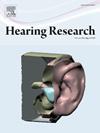整个生命周期中听力参数的发展。二、参数之间的关系
IF 2.5
2区 医学
Q1 AUDIOLOGY & SPEECH-LANGUAGE PATHOLOGY
引用次数: 0
摘要
衰老与听力功能的复杂退化有关,其范围从外围到中枢听觉结构。为了描述这一过程,我们测量了290名年龄在18岁至87岁之间的健康志愿者的一系列听觉参数。在我们的同伴论文中,我们研究了个体听觉参数的年龄相关进展,目的是确定年龄几十年的平均参数。本文的重点是评估这些变量之间的关系,这些变量也可能随着年龄和听力状况的变化而变化。我们提出了三种类型的分析:1)变量聚类,2)基于基本听觉参数的语音理解能力预测,以及3)变量之间的相互相关性。分析是在几个选定的亚组中进行的,比如那些听力阈值很好的人,或者属于某个年龄组的人。研究结果支持了这样一种假设,即个体听觉功能是相互关联的,并可能被归类为更普遍的特征,如“听觉敏感性”或“时间处理”。然而,听觉变量的分组并不是普遍的,变量之间的关系在不同的被试亚组中存在显著差异。此外,对言语理解能力的预测表明,言语理解依赖于不同年龄和听力状况的不同机制。我们的结论是,听觉功能之间的关系随着年龄的增长而发展,并逐渐发展到更大的相互依存关系;因此,听力能力表型的最终分类必须考虑受试者的年龄。本文章由计算机程序翻译,如有差异,请以英文原文为准。
Development of audiometric parameters throughout the lifespan. II: Relationships between parameters
Aging is associated with a complex deterioration of hearing functions, which spans from the periphery to central auditory structures. To characterize this process, we measured a wide set of auditory parameters in 290 healthy volunteers aged from 18 to 87 years. In our companion paper, we investigate the age-related progression of individual auditory parameters with the objective of determining average parameters in age decades. The current paper focuses on evaluation of relationships between the variables, which may also change depending on the age and hearing status. We present three types of analyses: 1) clustering of variables, 2) predictions of speech comprehension ability based on the elementary auditory parameters, and 3) mutual correlations between the variables. The analyses are performed in several selected subgroups of subjects, such as those having excellent hearing threshold, or those belonging to a certain age group. The results support the hypothesis that individual auditory functions are interrelated and may be clustered into more general characteristics such as “hearing sensitivity” or “temporal processing”. However, grouping of auditory variables is by no means universal and the relationships between variables markedly differ in different subject subgroups. In addition, predictions of speech comprehension ability indicate that speech understanding relies on different mechanisms depending on age and hearing status. We conclude that relationships among auditory functions develop during aging and gradually progress to larger interdependence; eventual classification of phenotypes of hearing abilities must thus consider age of the subject.
求助全文
通过发布文献求助,成功后即可免费获取论文全文。
去求助
来源期刊

Hearing Research
医学-耳鼻喉科学
CiteScore
5.30
自引率
14.30%
发文量
163
审稿时长
75 days
期刊介绍:
The aim of the journal is to provide a forum for papers concerned with basic peripheral and central auditory mechanisms. Emphasis is on experimental and clinical studies, but theoretical and methodological papers will also be considered. The journal publishes original research papers, review and mini- review articles, rapid communications, method/protocol and perspective articles.
Papers submitted should deal with auditory anatomy, physiology, psychophysics, imaging, modeling and behavioural studies in animals and humans, as well as hearing aids and cochlear implants. Papers dealing with the vestibular system are also considered for publication. Papers on comparative aspects of hearing and on effects of drugs and environmental contaminants on hearing function will also be considered. Clinical papers will be accepted when they contribute to the understanding of normal and pathological hearing functions.
 求助内容:
求助内容: 应助结果提醒方式:
应助结果提醒方式:


